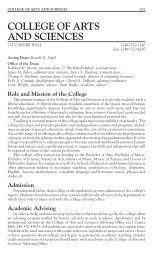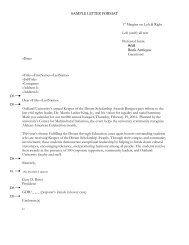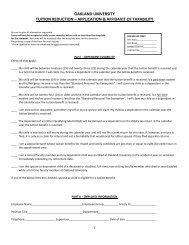MOM 2006 journal for pdf.pmd - University of Michigan-Flint
MOM 2006 journal for pdf.pmd - University of Michigan-Flint
MOM 2006 journal for pdf.pmd - University of Michigan-Flint
Create successful ePaper yourself
Turn your PDF publications into a flip-book with our unique Google optimized e-Paper software.
(Gough, 1957). Because individuals high in socialization are expected to be more empathic <strong>of</strong><br />
characters caught in a moral dilemma, hypothesis 3 predicted that individuals with higher scores<br />
(lower sociopathy) would be more likely to give a lower level <strong>of</strong> punishment to hypothetical<br />
“immoral” characters in Kohlberg’s Moral Dilemmas.<br />
Method<br />
Participants and Scales<br />
The sample consisted <strong>of</strong> 105 undergraduate students (20 males and 85 females) who<br />
volunteered <strong>for</strong> the study to earn credit <strong>for</strong> an introductory psychology course. Machiavellianism<br />
was determined by scores on the Mach V Scale (Christie, 1969), a test that uncovers<br />
Machiavellian traits by having participants rate statements culled from The Prince and The<br />
Discourses by Niccolo Machiavelli. Subjects rate 20 sets <strong>of</strong> 3 statements, indicating one<br />
statement that is “most true” and one that is “most false” <strong>for</strong> them. Scores can range from 40-160<br />
with higher scores indicating higher Mach levels.<br />
Levels <strong>of</strong> sociopathy were determined by scores on the Socialization Scale (So) <strong>of</strong> the CPI<br />
(Gough, 1957). Scores on the So scale reflect empathy <strong>for</strong> others and the degree to which a<br />
person accepts and adheres to social norms. Subjects’ scores fall on a continuum from highly<br />
socialized (highest scores) to highly antisocial (i.e., sociopathic).<br />
Measures<br />
Kohlberg’s Moral Dilemmas (Colby et al., 1987) consist <strong>of</strong> four hypothetical stories about<br />
individuals in moral dilemmas and their subsequent behavior. Each story is followed by one<br />
question asking about assignment <strong>of</strong> blame and a second indicating level <strong>of</strong> punishment that the<br />
individual should receive. The Prisoner’s Dilemma game (Goren & Bornstein, 2000) requires<br />
each subject to choose to either cooperate or not with an opponent in order to maximize points<br />
earned. The game was programmed to include a “random” opportunity to cheat.<br />
Procedures<br />
Two participants who had been waiting together <strong>for</strong> the experiment to begin were led into<br />
separate laboratory rooms. They were asked to read and complete a consent <strong>for</strong>m and to write<br />
their name and address on an envelope, so that the test results and a debriefing letter could be<br />
sent to them. All questionnaires and moral dilemmas were programmed on lab PCs. The first<br />
questionnaire asked <strong>for</strong> demographic in<strong>for</strong>mation (age, college major, and gender). The Mach V,<br />
Kohlberg Moral stories, and CPl-So scale were given in a random order, followed by the<br />
prisoner’s dilemma game. Participants were led to believe they were playing the participant in the<br />
other room. This was done using a randomly timed screen that appeared to be waiting <strong>for</strong> the<br />
other player. Additionally, after every game entry, the computer would randomly pause between<br />
two and four seconds to give the impression that the other player was selecting an answer. Upon<br />
completion, participants were thanked <strong>for</strong> their participation and excused.<br />
Meeting <strong>of</strong> Minds <strong>2006</strong> 43
















